Farming technology has advanced significantly in recent years, and one of the most impactful innovations has been tractor guidance system. These systems promise increased efficiency and precision, but some farmers still prefer the traditional approach of manual driving. In this article, we explore the differences between tractor guidance systems vs. manual driving and help you determine which option may be better for your farm.
What Are Tractor Guidance Systems?
Tractor guidance systems are advanced technologies that use GPS, sensors, and software to automate the steering of tractors. These systems can maintain straight rows, optimize field coverage, and reduce overlap during planting, spraying, or harvesting. Some guidance systems even integrate with other smart farming technologies, allowing for fully automated operations with minimal human input.
Key Benefits of Tractor Guidance Systems
- Precision Farming: Tractor guidance systems reduce overlaps and gaps, ensuring efficient use of seeds, fertilizers, and pesticides.
- Reduced Fatigue: Operators can focus on monitoring equipment rather than constantly steering the tractor.
- Time Savings: Automated guidance allows tractors to work faster and for longer hours without compromising accuracy.
- Cost Efficiency: Over time, reduced input waste and improved crop yields can offset the cost of implementing guidance systems.
The Case for Manual Driving
Despite the advancements in automation, manual driving still has its advantages. Skilled operators can adapt quickly to challenging terrain, unexpected obstacles, or weather conditions that may confuse automated systems. Manual driving also allows for more hands-on control, which some farmers prefer for certain operations or smaller fields.
Advantages of Manual Driving
- Flexibility: Operators can make on-the-fly adjustments to suit field conditions.
- Lower Initial Costs: No need to invest in expensive technology.
- Reliability: Manual tractors do not rely on GPS signals or software updates, reducing the risk of system failures.
Tractor Guidance Systems vs. Manual Driving: Which Is Better?
The choice between tractor guidance systems vs. manual driving largely depends on your farm size, budget, and priorities. Large-scale farms benefit the most from automated guidance due to time savings, precision, and reduced labor costs. Smaller farms or farms with irregular terrain may still find manual driving to be practical and cost-effective.
Factors to Consider
- Field Size: Large, uniform fields favor tractor guidance systems.
- Budget: Manual driving requires minimal investment, while guidance systems can be expensive.
- Operator Skill: Less experienced operators may benefit more from automated systems.
- Maintenance and Reliability: Consider the costs and risks associated with maintaining advanced technology.
Conclusion
While tractor guidance systems vs. manual driving is a debate with no one-size-fits-all answer, modern trends suggest that automated systems are ideal for efficiency, precision, and long-term cost savings. However, manual driving remains relevant for flexibility and situations where technology may struggle. Ultimately, the best choice depends on the unique needs and goals of your farm.


